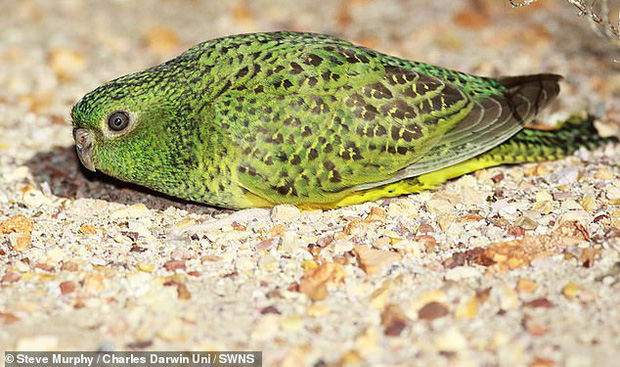With a nocturnal bird, parrots have a huge evolutionary error, which makes them more difficult to survive and once considered extinct.
Australia is still the same, always surprising us with the countless exotic species. From the most poisonous snakes on the planet, to creatures with a terrifying giant appearance. And this time, the “character” that surprised scientists was a species of nocturnal parrot, with the undeniable name … “Night Parrot”.
The nocturnal parrot is currently in danger, even considered extinct over 100 years ago, until the body of a parrot struck by a truck was found in 1990. In 2013, the science Traces of nocturnal parrots were found, even their habitats two years later, although the exact number in the herd has not been determined.
However, what is surprising comes from a recently published study. As a result, the scientists used tomography data of the skull of the nocturnal parrot from 1990, and discovered an unexpected fact: this parrot has extremely poor vision, even very bad at night. night.
The fact that a nocturnal bird did not evolve to see at night was truly a big mistake of nature. When they can’t see, they can easily run into man-made fences – which are used to protect sheep and livestock from predators. Not to mention that they can fly in the street by mistake and be struck by a car, leading to other tragic disasters.
“Nocturnal parrots need good eyesight to observe at night, in order to find food, to avoid obstacles, to avoid enemies,” says evolutionary biologist Vera Weisbecker of Flinders University in Adelaide
“Therefore, we would expect them to have a sufficient visual system to allow night vision, like other nocturnal birds, for example the New Zealand Kakapo parrots or owls. these things.”
This is based on Night Parrot’s brain reconstruction process from their rare, intact skull samples and then compared to other parrots. “We found that nocturnal parrots have the same eye size as other parrots, but have a smaller optic nerve,” said study author Aubrey Keirnan of the University of Queensland.
“The area of the optic lobe – which is responsible for observations of the brain is also smaller. This shows that nocturnal parrots do not seem to be good at observing in low light conditions.”
“Their eyesight is quite sensitive, but the resolution is not high. They have difficulty seeing objects like barbed wire, not even predators.”
In comparison, other nocturnal mammals have very large flowering pupils, in order to maximize light reception. This way, they can see better at night, stalk or protect themselves easily. And nocturnal parrots – again, they don’t have that.
According to Andrew Iwaniuk – co-author of the study from the University of Lethbridge (Canada), approaching this bird from an anatomical point of view is really a wise decision. “These parrots are so rare that we don’t even know how many are left.”
“In order to preserve, it is necessary to understand their behavior in order to make a correct decision. But since it is so rare, observation is almost impossible.”
“Removing unused fences should be a priority, especially in areas where nocturnal species appear.” Says Nick Leseberg, another author from the University of Queensland.
“However, we can’t just remove the fences. Livestock need them and preventing predators will also help protect nocturnal parrots.”




